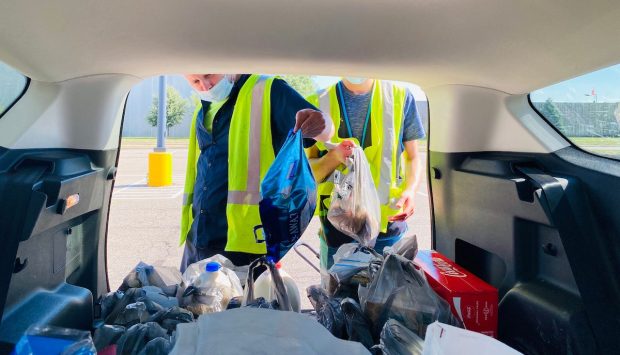US Grocers Lead Global Demand for Online Order and Pickup

When it comes to eCommerce pickup orders, PYMNTS research shows U.S. grocers at the forefront.
With the disproportionate adoption of the channel, American grocery retailers are leading the way on creating a quick and convenient pickup experience, be it in stores or from the comfort of consumers’ vehicles.
All over the world and across industries, pickup is on the rise, according to the “2023 Global Digital Shopping Index,” a PYMNTS and Cybersource collaboration, which drew from consumer panels from six countries spanning more than 13,000 participants. Across all geographies surveyed, the share of consumers who picked up their most recent eCommerce order in a store or curbside rose from 21% in 2021 to 26% in 2022.
Plus, in the United States, the increase was even more dramatic. That share rose from 23% to 32%, making the country a leader in adoption of pickup channels.
Moreover, in grocery, pickup adoption surpasses other retail categories. Research from the November/December edition of PYMNTS’ ConnectedEconomy™ study, “ConnectedEconomy™ Monthly Report: The Gender Divide Edition,” for which PYMNTS surveyed more than 2,600 U.S. consumers, found that 45% of men and 36% of women buy groceries online for curbside pickup. Similarly, 43% of men and 30% of women do so for in-store pickup.
Traditional grocers and emerging startups alike are adapting their business models to this demand. Regarding the former, category giants such as Kroger and Walmart have been investing in creating increasingly frictionless pickup options.
Kroger, the United States’ largest pure-play grocer, discussed the progress of its online grocery efforts on its most recent earnings call in December.
“Improving the customer experience is always top of mind for us and Kroger Pickup now offers three-hour pickup lead times at all stores in our network, with as little as one-hour lead time in some areas,” Kroger CEO Rodney McMullen told analysts at the time.
Walmart, the world’s largest grocer, has been focusing on its pickup business as part of an overarching effort to drive omnichannel engagement, with each fulfillment method complementing the others. On Walmart’s Q3 earnings call, the company discussed its goal to invest further in this strategy going forward.
“For a long time, we talked about the value of a store customer plus shopping on eComm how much more valuable that was,” said Walmart U.S. President and CEO John Furner. “We see that accelerate when it’s pickup, eCommerce and stores. So going forward, you’ll hear us talk about this more and more as an omni-offer, which is really flexible for the customer.”
Meanwhile, some emerging grocers are going the opposite route, looking away from omnichannel toward maximizing pickup sales. Across the country, a handful of grocers are emerging that offer a curbside-only model. Most recently, Addie’s, the self-proclaimed “first drive-up grocer” on the East Coast, announced in a Thursday (Jan. 26) news release the close of a $10.1 million seed funding round to power its expansion.
“With our seed funding, we’ve built an end-to-end experience to serve people in and around Norwood in a way that can be replicated in suburbs nationwide,” Addie’s CEO and Co-founder Jim McQuade said in the release. “We look forward to quickly expanding, offering busy families across the country drive-up grocery convenience without compromise.”
The news comes just a couple weeks after another curbside-only grocer in Oklahoma, JackBe, opened its doors. Other grocers, meanwhile, are going after the in-store pickup customer. In October, British food delivery company Deliveroo opened a physical grocery store in Central London in partnership with Morrisons, the U.K.’s fourth-largest grocer, offering on-stie pickup for online orders.
As pickup continues to grow in popularity around the world, it is likely that more store formats and omnichannel initiatives will emerge to enable grocers to maximize their digital sales and drive engagement across the whole business.
